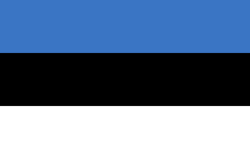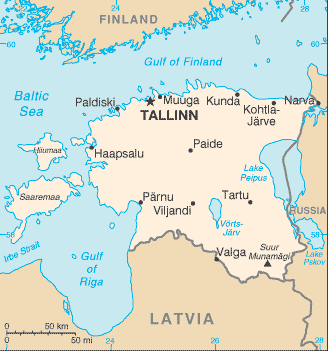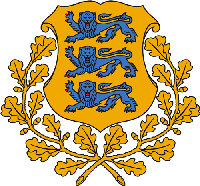Republic of Estonia
Related Categories:
 Flag of Estonia
Flag of EstoniaPre-1940 flag restored by Supreme Soviet in May 1990 - three equal horizontal bands of blue (top), black, and white. |


|
The coat of arms, the national colours and the national anthem officially became Estonia's after the War of Independence of 1918 - 1920, when the Republic of Estonia was internationally recognized. All three symbols had existed long before.
www.einst.ee/
Description of the Flag, Legislation, Vertical Banner, Table Flag, Pennant.
www.fotw.us/
The Estonian people are ethnically related to the Finns. The Estonian language is one of the Finno-Ugric languages and as such, along with its close relative Finnish as well as Hungarian, is one of the few official languages of the European Union that is not of Indo-European origin.
en.wikipedia.org/
Estonians belong to the Balto-Finnic group of the Finno-Ugric peoples, as do the Finns and the Hungarians. Archaeological research confirms the existence of human activity in the region as early as 8,000 BC, but by 3,500 BC the principal ancestors of the Estonians had arrived from the east.
Estonians have strong ties to the Nordic countries today stemming from deep cultural and religious influences gained over centuries during Scandinavian colonization and settlement. This highly literate society places great emphasis upon education, which is free and compulsory until age 16. About 20% of the population belongs to the following churches registered in Estonia: Estonian Evangelical Lutheran Church, Estonian Apostolic Orthodox Church, Estonian Orthodox Church subordinated to the Moscow Patriarchate, Baptist Church, Roman Catholic Church, and others.
As of November 2006, 84.6% of Estonia's population held Estonian citizenship, 7.6% were citizens of other countries (primarily Russia), and 8.8% were of undetermined citizenship.
Written with the Latin alphabet, Estonian is the language of the Estonian people and the official language of the country. Estonian is one of the world's most difficult languages to learn for English-speakers: it has fourteen cases, which can be a challenge even for skilled linguists. During the Soviet era, the Russian language was imposed for official use.
www.state.gov/r/
Introduction
About
Contact
Symbols in The News
Interpret this Symbol
AAC
African
AI
Alchemy
Alphabets
Ancient
Animal Symbolism
Architecture
Art
Articles
Astrology
Baha'i
Blissymbolics
Blueprint Symbols
Buddhist
Celtic Symbols
Cemetery
Chinese Symbols
Christian
Circle
City
Codes
Color
Conlangs
Crop Circles
Danger
Da Vinci Code
Designing Logos
Dictionaries
Dreams
Education
Egyptian Symbols
Electrical
Emoticons
Find Images
Fonts
Food
Fraternity
Hamsa
Healing
Heraldry
Hermetic
Highway Signs
Hindu
History
Hobo
Holiday
Icons
iConji
Islamic
Jain Symbols
Japanese, Kanji
Jewish
Justice
Law
Literary Symbolism
Mandalas
Map
Masonic
Math, Number
Meaning of Names
Medical
Middle East
Military
Miscellaneous
Money
Music
Mythology
Native American
Playing Cards
Power
Psychology
QiQiiKhu
Reiki
Religious
Runes, Norse
Sacred Geometry
Scientific
Science Fiction
Sorority
Sports
Symbols in the News
Tattoos
ThirteenSymbols
Tree of Life
Ursprache
Videos
Visual Languages
Weather
Web Codes
Wicca
Words
Writing Systems
Braille
Coinherence
Coptic
Cuneiform
Easter Island
Etruscan
Happy Human
Hebrew
Kokopelli
Linear B
Lotus
Love Symbols
Mandorla
Moon Alphabet
Nine Pointed Star
Om
Oz
Phonetic
Scarab Beetle
Silent
Theosophy
Unifon
About
Contact
Symbols in The News
Interpret this Symbol
AAC
African
AI
Alchemy
Alphabets
Ancient
Animal Symbolism
Architecture
Art
Articles
Astrology
Baha'i
Blissymbolics
Blueprint Symbols
Buddhist
Celtic Symbols
Cemetery
Chinese Symbols
Christian
Circle
City
Codes
Color
Conlangs
Crop Circles
Danger
Da Vinci Code
Designing Logos
Dictionaries
Dreams
Education
Egyptian Symbols
Electrical
Emoticons
Find Images
Fonts
Food
Fraternity
Hamsa
Healing
Heraldry
Hermetic
Highway Signs
Hindu
History
Hobo
Holiday
Icons
iConji
Islamic
Jain Symbols
Japanese, Kanji
Jewish
Justice
Law
Literary Symbolism
Mandalas
Map
Masonic
Math, Number
Meaning of Names
Medical
Middle East
Military
Miscellaneous
Money
Music
Mythology
Native American
Playing Cards
Power
Psychology
QiQiiKhu
Reiki
Religious
Runes, Norse
Sacred Geometry
Scientific
Science Fiction
Sorority
Sports
Symbols in the News
Tattoos
ThirteenSymbols
Tree of Life
Ursprache
Videos
Visual Languages
Weather
Web Codes
Wicca
Words
Writing Systems
Braille
Coinherence
Coptic
Cuneiform
Easter Island
Etruscan
Happy Human
Hebrew
Kokopelli
Linear B
Lotus
Love Symbols
Mandorla
Moon Alphabet
Nine Pointed Star
Om
Oz
Phonetic
Scarab Beetle
Silent
Theosophy
Unifon
